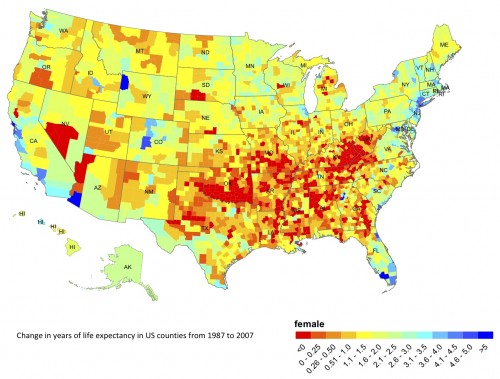The Washington Post notes a new study from The Institute for Health Metrics and Evaluation looking at changes in life expectancy changes from 1987-2007 by county:
While people in Japan, Canada, and other nations are enjoying significant gains in life expectancy every year, most counties within the United States are falling behind, according to a new study by the Institute for Health Metrics and Evaluation (IHME) at the University of Washington.
IHME researchers, in collaboration with researchers at Imperial College London, found that between 2000 and 2007, more than 80% of counties fell in standing against the average of the 10 nations with the best life expectancies in the world, known as the international frontier.
“We are finally able to answer the question of how the US fares in comparison to its peers globally,” said Dr. Christopher Murray, IHME Director and one of the paper’s co-authors. “Despite the fact that the US spends more per capita than any other nation on health, eight out of every 10 counties are not keeping pace in terms of health outcomes. That’s a staggering statistic.”
Here’s the most troubling part (emphasis mine):
Change in life expectancy is so uneven that within some states there is now a decade difference between the counties with the longest lives and those with the shortest. States such as Arizona, Florida, Virginia, and Georgia have seen counties leap forward more than five years from 1987 to 2007 while nearby counties stagnate or even lose years of life expectancy. In Arizona, Yuma County’s average life expectancy for men increased 8.5 years, nearly twice the national average, while neighboring La Paz County lost a full year of life expectancy, the steepest drop nationwide. Nationally, life expectancy increased 4.3 years for men and 2.4 years for women between 1987 and 2007.
A couple of take home points.
The authors believe their data cannot be explained by race, economics, or the size of the nation. They further state that preventable factors, such as smoking and obesity, are partly to blame. They therefore argue that the health care system can’t be the fix for this, that what are needed are public health interventions. I think that’s missing the big picture. We waste so much money in the health care system that there’s too little left for public health interventions. Public health should be part of the health care system, and we need to shift spending towards more prevention and primary care.
Moreover, did you see my emphasis? Some counties in the US saw life expectancy drop over the last twenty years. Look at this map:
The red areas are where life expectancy fell over twenty years for women. I’m willing to bet those also happen to be some of the poorest areas of the country. Think about that whenever someone talks about increasing the eligibility age for Medicare or Social Security. The people who lose the most benefits are also likely those who need the programs the most.
UPDATE: Edited for clarity


